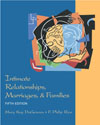Remarriage has become quite common accounting for 46 percent of marriages.
Remarried families may have one or two remarried spouses, often with children,
thereby creating stepfamilies. Challenges are common in relationships with children,
ex-spouses, and stepsiblings. Patterns of courtship and mate selection differ
from those of first marriages, with motivations and expectations being influenced
by children, ex-spouses, and family members. Problems can result, such as replicating
the mistakes of the first marriage and being fearful and oversensitive of first-marriage
difficulties. Other problems arise because of confusion over role expectations
and enactment, financial problems, jealousy over the former spouse, and remarriage
and marital conflict. Successful remarrieds take sufficient time with each other,
develop good communication patterns, and put their marriage first. Three ways
in which stepparents attempt to develop a bond with their stepchild are nonseeking
of affinity, early seeking of affinity, and continuous affinity seeking. Of
these, continuous affinity seekers experience the highest degree of success.
Cooperative types of parenting, such as co-parenting or parenting coalitions,
have advantages for both children and parents. Stepsibling rivalry can be acute.
Having a new baby in a stepfamily will often improve stepsibling relationships,
but it can also complicate sibling rivalry. |



 2002 McGraw-Hill Higher Education
2002 McGraw-Hill Higher Education